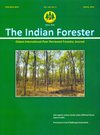Soil Organic Carbon Stocks Under Different Forest Types in India
DOI:
https://doi.org/10.36808/if/2016/v142i3/90955Keywords:
Soil Organic Carbon Stock, Forests, Forest Types, India.Abstract
India has stabilized its forest and tree cover which is about 24.01 per cent of its total geographical area. Forests store significant amounts of carbon in its biomass, litter, dead woods and soil; and it has a major role in climate change adaptation and mitigation. Soil carbon is the largest terrestrial carbon pool and it holds a very important role in the carbon cycle. Soil samples were collected from all major forest types in different parts of the country as well as from adjoining non-forest areas for estimating the loss of soil organic carbon due to land conversion. The results of this study indicated that maximum soil organic carbon stock was under tropical moist deciduous forests (1665.65 million tonnes) followed by tropical dry deciduous forests (1572.38 million tonnes) and least under Himalayan dry temperate forests (3.85 million tonnes). The total soil organic carbon stocks i.e., 4327.36 million tonnes and 4680.25 million tonnes were estimated under the forests in the year 1995 and 2007 respectively. The estimate showed that due to increase in forest cover during the assessment period, soil in Indian forests acted as a net sink of 352.89 million tonnes of soil organic carbon. The maximum increase in soil organic carbon stock during this period was under tropical moist deciduous forests (125.91 million tonnes) and the least increase was under Himalayan dry temperate forests (0.23 million tonnes).References
Batjes N.H. (1996). Total carbon and nitrogen in the soils of the world. Euro. J. Soil Sci., 47: 151-163.
Champion H.G. and Seth S.K. (1968). A revised survey of forest types of India. Manager of Publications, Delhi.
Chhabra A. and Dadhwal V.K. (2005). Forest soil organic carbon pool – an estimate and review of Indian studies. Indian Forester, 131 (2): 201-214.
Dadhwal V.K. and Nayak S.R. (1993). A preliminary estimate of bio-geochemical cycle of carbon for India. Science and Culture, 59 (1&2): 9- 13.
Dadhwal V.K., Pandya N. and Vora A.B. (1998). Carbon cycle for Indian forest ecosystem: A preliminary estimate. In: Global change studies: Scientific results from ISRO – GBP (Subbaraya, B.H.., Rao, D.P., Desai, P.S., Manikiam, Rajaratnam, P. Eds.), ISRO, Bangalore, pp. 411- 430.
Davidson E.A., Trumbore S.E. and Amudson R. (2000). Soil warming and organic carbon content. Nature, 408: 789-790.
Dixon R.K., Brown S., Houghton R.A., Solomon A.M., Trexler M.C. and Wisneiwski J. (1994). Carbon pools and flux of global forest ecosystems. Science, 263:185-190.
FAO (2005). State of the World's Forests. FAO, Rome, pp. 153.
FAO (2010). Global Forest Resource Assessment 2010. FAO Forestry Paper 163, Food and Agriculture Organisation of the United Nations, Rome, p. 340.
14 Follett R.F., Paul E.A. and Pruessner E.G. (2007). Soil carbon dynamics during a long term incubation study involving C and C measurements. Soil Science, 172 (3): 189 – 208.
FSI (n.d.). Carbon Stocks in India's Forests. Forest Survey of India. Dehradun.
FSI (2009). India State of Forest Report. Forest Survey of India, Dehradun.
FSI (2013). India State of Forest Report. Forest Survey of India, Dehradun.
IPCC (1997). Landuse change and forestry. In:'Revised 1996 IPCC Guidelines for National Greenhouse Gas Inventories: Reference Manual, Volume 3', J.T. Houghton, L.G. Meira Filho, B. Lim, K. Treanton, I. Mamaty, Y. Bonduki, D.J.Griggs and B.A. Callander (Eds.). Intergovernmental Panel on Climate Change, Jenava.
Jenny H. and Raychaudhuri S.P. (1960). Effect of climate and cultivation on nitrogen and organic matter reserves in Indian soils. Indian Council of Agricultural Research, New Delhi, p. 126.
Kishwan J., Pandey R. and Dadhwal V.K. (2009). India's Forest and Tree Cover, Technical Paper. Indian Council of Forestry Research and Education, Dehradun.
Lal R. and Kimble J. (1997). Land use and soil C pools in terrestrial ecosystems. In: Management of carbon sequestration in soil (R. Lal et al. Eds.). CRC Press. Boca Raton, FI. P. 1-10.
Lal R. and Bruce J.P. (1999). The potential of world cropland soils to sequester C and mitigate the greenhouse effect. Environmental Science and Policy, 2: 177-185.
MoEF (2012). India Second National Communication to the United Nations Framework Convention on Climate Change. Ministry of Environment and Forests, Government of India.
Parks P.J. and Hardie I.W. (1995). Least-cost forest carbon reserves: Cost effective subsidies to convert marginal agricultural land to forests. Land Economics, 71(1): 122:136.
Post W.M., Pengh T.H., Emanuel W., King A.W., Dale V.H. and Delnglis (1990). The global carbon cycle. American Science, 78: 310-326.
Pregitzer K.S. (2003). Woody plants, carbon allocation and fine roots. New Phytologist, 158 (3): 421-424.
Ravindranath N.H., Somashekhar B.S. and Gadgil M. (1997). Carbon flows in Indian forests. Climatic Change, 35(B): 297-320.
Schwartz D. and Namri M. (2002). Mapping total organic carbon in the soils of the Congo. Global and Planetary Change, 33: 77-93.
Song G., Li L., Pan G. and Zhang Q. (2005). Topsoil organic carbon storage of China and its loss by cultivation. Biogeochemistry, 74 (1): 47-62
Tian H., Melillo J.M. and Kicklighter D.W. (2002). Regional carbon dynamics in monsoon Asia and implications for the global carbon cycle. Global and Planetary Change, 37: 201-217.
Walkley A.E. and Black J.A. (1934). An examination of the Degitjareff method for determining soil organic matter and proposed modification of the chromic acid titration method. Soil Science, 37:29-38.
Wilde S.A., Voigt G.K. and Iyer J.G. (1964). Soil and Plant Analysis for Tree Culture. Oxford Publishing House, Calcutta, India.
Downloads
Downloads
Published
How to Cite
Issue
Section
License
Unless otherwise stated, copyright or similar rights in all materials presented on the site, including graphical images, are owned by Indian Forester.





